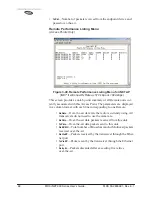
90
MDS iNET 900 Series User’s Guide
MDS 05-2806A01, Rev. E.1
Tips for Optimizing Network Performance
Here are some suggestion on things to try that may maximize
throughput:
1. AP Only: Increment the
Dwell Time
to the maximum of 262.1 ms.
This lowers the overhead since it will stay longer on a channel. The
down side is that if a particular channel is interfered with it will take
longer to hop to another channel.
(
Main Menu>>Radio Configuration>>Dwell Time
)
2. AP Only: Change the
Beacon Period
to
Normal
(508 ms). This will
also reduce the overhead of beacons sent out. On the down side,
association time may be a little longer.
(
Main Menu>>Radio Configuration>>Beacon Period
)
3. Change the
Fragmentation Threshold
to the maximum of 1600. Longer
packets will be sent over the air reducing overhead. On the down
side, if a packet is corrupted it will take longer to be retransmitted.
(
Main Menu>>Radio Configuration>>Fragmentation Threshold
)
4. Increase the
RTS Threshold
to 1600. RTS mechanism is used to
reserve a time slot if packets exceed this number. On the down side,
a hidden-node might interfere more often than if RTS is not used.
(
Main Menu>>Radio Configuration>>RTS Threshold
)
5. Decreasing the
RTS Threshold,
to the 100 to 200 range, will improve
throughput on a busy network. It will add small packets, but reduce
collisions (and resulting re-tries) of large packets.
(
Main Menu>>Radio Configuration>>RTS Threshold
)
6. Use the
Performance Information Menu
to check the packets received by
zone. (Remotes Only:
Main Menu>>Performance Information>>Packet
Statistics>>Packets Received by Zone
)
Readings should be close in value. A significantly lower value (2%
reduction) probably indicates interference. Performance can be
improved by blocking the affected zones at the Access Point. (
Main
Menu>>Radio Configuration>>Skip Zone Option
)
7. Use the
Performance Information Menu
to check for errors, retries and
dropped packets. Do the same with Ethernet traffic.
With weak signals, interference, or hidden nodes, the optimal per-
formance may be lower due to collisions and retries.
Data Latency—TCP versus UDP Mode
The latency of data passing through a network will depend on user data
message length, the overall level of traffic on the network, and the
quality of the radio path.
Содержание iNET 900 Series
Страница 10: ...2 MDS iNET 900 Series User s Guide MDS 05 2806A01 Rev E 1 ...
Страница 26: ...18 MDS iNET 900 Series User s Guide MDS 05 2806A01 Rev E 1 ...
Страница 118: ...110 MDS iNET 900 Series User s Guide MDS 05 2806A01 Rev E 1 ...
Страница 120: ...112 MDS iNET 900 Series User s Guide MDS 05 2806A01 Rev E 1 ...
Страница 136: ...128 MDS iNET 900 Series User s Guide MDS 05 2806A01 Rev E 1 ...
Страница 148: ...140 MDS iNET 900 Series User s Guide MDS 05 2806A01 Rev E 1 ...
Страница 150: ...142 MDS iNET 900 Series User s Guide MDS 05 2806A01 Rev E 1 ...
Страница 164: ...156 MDS iNET 900 Series User s Guide MDS 05 2806A01 Rev E 1 ...
Страница 172: ...164 MDS iNET 900 Series User s Guide MDS 05 2806A01 Rev E 1 ...






























